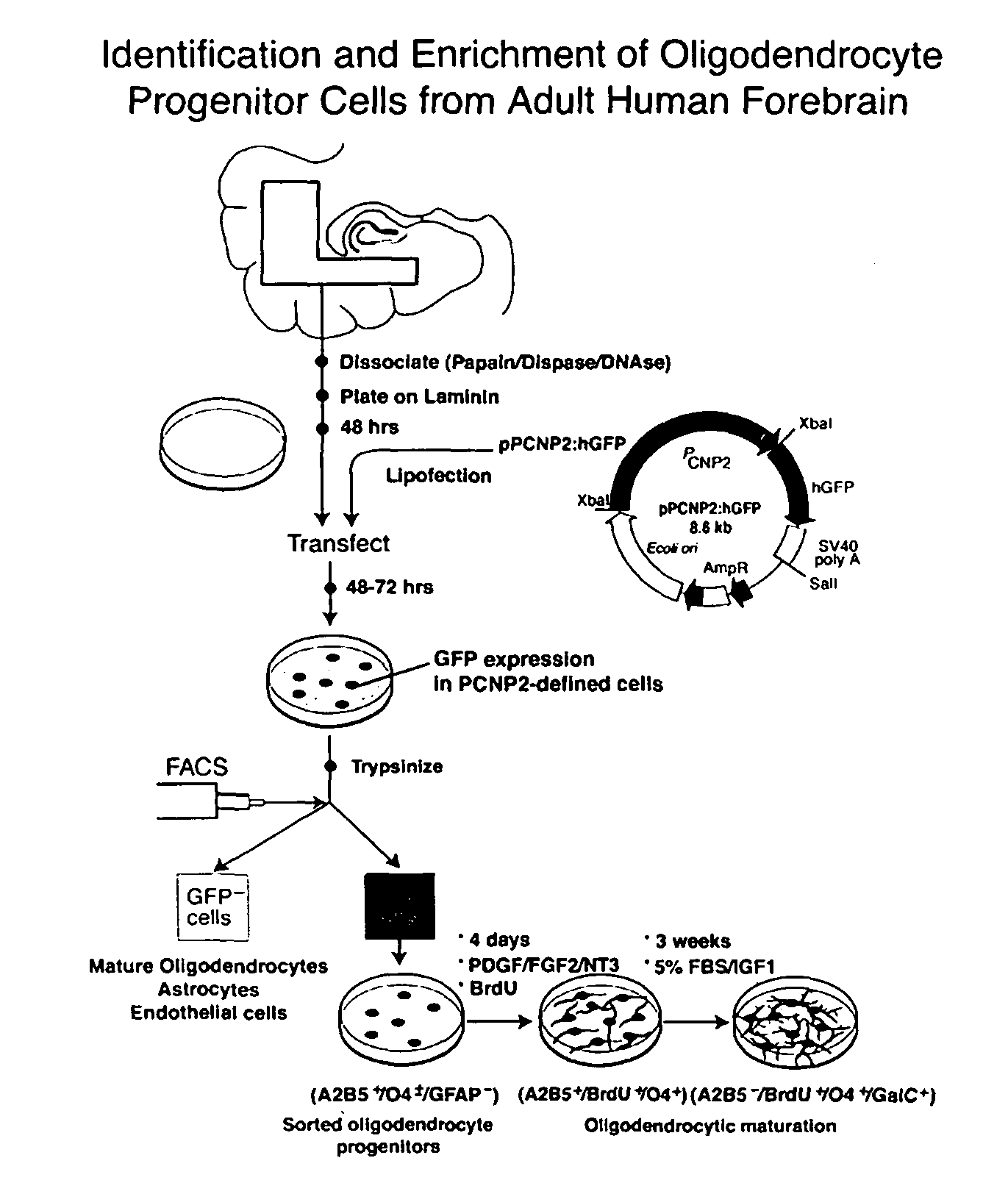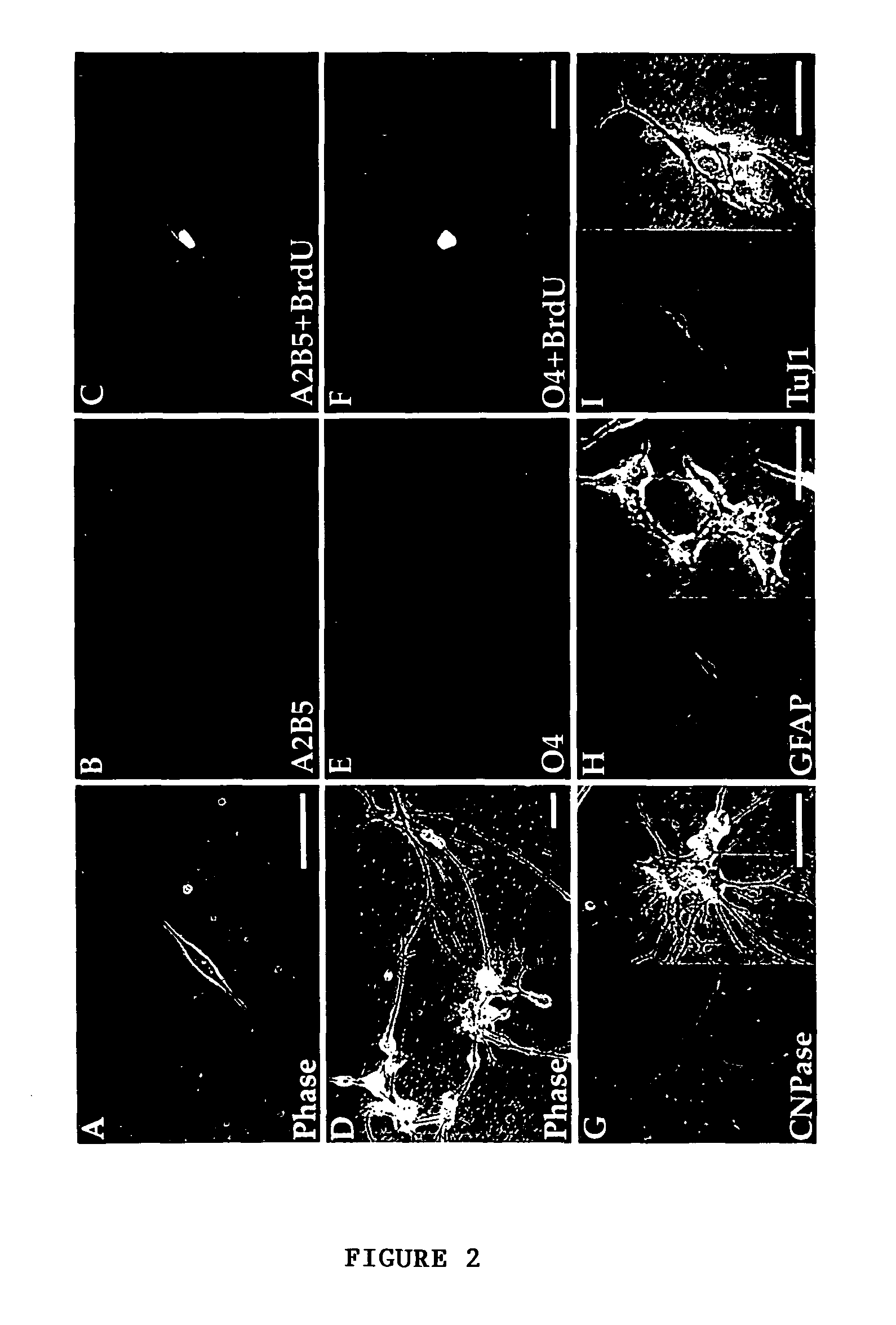Method for isolating and purifying oligodendrocytes and oligodendrocyte progenitor cells
a technology of oligodendrocytes and progenitor cells, applied in the field of separating cells of interest, can solve the problems of inability of damaged brain to function significantly structural self-repair, relative scarcity of adult brain tissue, and failure of mature brain to generate new neurons, etc., and achieve the effect of acceleration in the study
- Summary
- Abstract
- Description
- Claims
- Application Information
AI Technical Summary
Benefits of technology
Problems solved by technology
Method used
Image
Examples
example 1
Materials and Methods
Plasmid Construction
[0048]P / hCNP2:hGFP and P / hCNP2:lacZ Humanized GFP (hGFP), a mutant form of GFP optimized for expression in human cells (Levy, et al., 1996, which is hereby incorporated by reference), was placed under the control of the human CNP2 promoter (Douglas, et al., 1992; Monoh, et al, 1993; and Gravel, et al., 1996). The human CNP gene had been isolated previously (Gravel, et al., 1996), by screening a human fibroblast genomic library with a cDNA probe for rat CNP1. The human CNP gene was then subcloned into pBluescript, and the resultant plasmid was designated SK / hgCNP. This plasmid was digested with BgIII and XhoI to delete much of the gene downstream of the promoter region. The remaining BgIII and XhoI ends were then filled-in and blunt-end ligated, yielding plasmid SK / P1P2hCNP, in which both BgIII and XhoI were regenerated. A 1123 bp XhoI-XhoI fragment containing SV40 SD / SA-GFPh-SV40 poly(A) was then excised from pTα1:hGFP (Wang, et al., 1998), a...
example 2
Dissociates of Adult Human White Matter Harbored a Pool of Bipolar, A2B5+ Cells
[0055]To fully characterize the cell phenotypes resident in adult human white matter, papain dissociates of surgically-resected frontal and temporal capsular white matter were obtained from 8 patients. These included 4 males and 4 females, who ranged from 24-65 years old. Three patients had temporal lobe resections for medication-refractory epilepsy; 2 were subjected to parenchymal excision during meningioma resection, 2 samples were taken during aneurysmal repair, and 1 was taken from the non-neoplastic approach to a histologically benign ganglioglioma. The monolayer cultures resulting from these white matter dissociations were stained after 5-7 days in vitro (DIV) for either of 2 oligodendrocytic markers, that included the epitopes recognized by the A2B5 and O4 antibodies. Additional, matched cultures were stained after 14 DIV, for either A2B5 or O4, for oligodendrocytic CNP protein, or for either neuro...
example 3
The CNP2 Promoter Targeted GFP Expression to a Bipolar, A2B5+ Phenotype
[0058]To identify either oligodendrocyte progenitor cells or their immature progeny, white matter dissociates were next transfected with plasmids encoding P / hCNP2:hGFP. Within 4 days after transfection with P / hCNP2:hGFP, a small proportion of GFP+ cells were noted. These were invariably small, bipolar cells, and constituted + / O4± / GFAP− / TuJ1−: 62.5±8.8% of P / hCNP2:hGFP+ cells expressed A2B5-IR, 21.1±7.5% were O4+, and another 7.3±3.2% expressed astrocytic GFAP. None were recognized by MAb TuJ1, which targets neuronal βIII-tubulin (Menezes, et al., 1994, which is hereby incorporated by reference). Thus, within the first 7-10 days in culture, P / hCNP2:hGFP selectively identified a population of bipolar, A2B5+ cells. When followed over the weeks thereafter, most of these P / hCNP2:hGFP+ cells developed into oligodendrocytes, that could be recognized by their small, multipolar, heavily branching profiles. Indeed, by 4 we...
PUM
 Login to View More
Login to View More Abstract
Description
Claims
Application Information
 Login to View More
Login to View More - R&D
- Intellectual Property
- Life Sciences
- Materials
- Tech Scout
- Unparalleled Data Quality
- Higher Quality Content
- 60% Fewer Hallucinations
Browse by: Latest US Patents, China's latest patents, Technical Efficacy Thesaurus, Application Domain, Technology Topic, Popular Technical Reports.
© 2025 PatSnap. All rights reserved.Legal|Privacy policy|Modern Slavery Act Transparency Statement|Sitemap|About US| Contact US: help@patsnap.com



